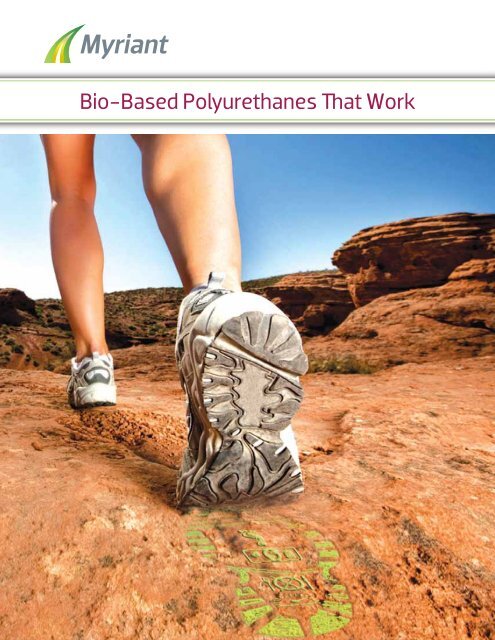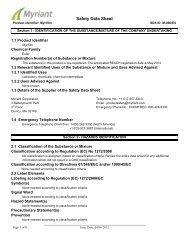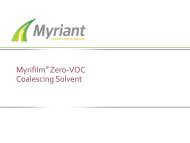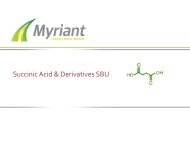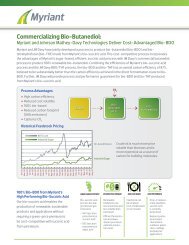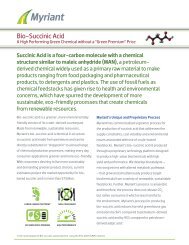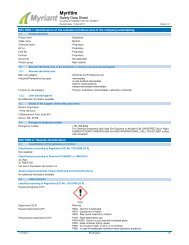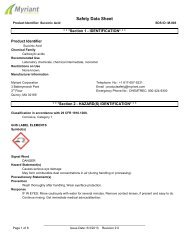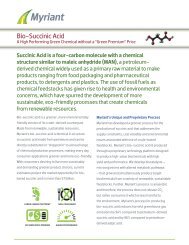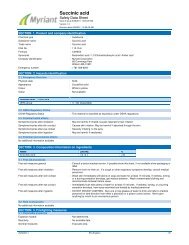Polyol Technical Bulletin - Myriant
Polyol Technical Bulletin - Myriant
Polyol Technical Bulletin - Myriant
Create successful ePaper yourself
Turn your PDF publications into a flip-book with our unique Google optimized e-Paper software.
Bio-Based Polyurethanes That Work<br />
Zero VOC
Polyurethanes: The Case For Renewable Polyester <strong>Polyol</strong>s<br />
Consumers of bio-based intermediates enjoy more stable costs than<br />
their competitors using petroleum-based intermediates. <strong>Myriant</strong>’s<br />
Developmental Polyester <strong>Polyol</strong>s are made from bio-succinic acid,<br />
and will allow polyurethane manufacturers to make products with a<br />
smaller environmental footprint and no performance penalty, at a<br />
competitive cost.<br />
Polyester <strong>Polyol</strong>S - BUILDING BLOCKS FOR THE THINGS YOU USE EVERYDAY<br />
Petroleum-based polyester polyols are in everything from couches and mattresses to packaging and toys. As<br />
consumer demand grows for “greener” products, manufacturers seek solutions for producing polyester polyols<br />
that reduce their reliance on petroleum. <strong>Myriant</strong> has that solution.<br />
<strong>Myriant</strong> has produced a line of developmental polyester polyols using bio-succinic acid as a raw material. While<br />
<strong>Myriant</strong> will not be manufacturing or selling polyester polyols, we are offering these materials in an effort to assist<br />
polyol formulators in exploring the advantages of bio-succinic acid in polyurethanes.<br />
Page 1
Polyester <strong>Polyol</strong> Chemistry<br />
Making Polyurethanes Greener<br />
<strong>Myriant</strong>’s Bio-Succinic Acid Can Replace Adipic Acid in <strong>Polyol</strong>s, Which Increases the Renewable<br />
Content Up to 100% Based on the Choice of Diol.<br />
Adipic acid is the most common aliphatic diacid used to make polyester polyols. Succinic acid has the same<br />
chemical properties as adipic acid and thus can generally be used without changes to the manufacturing process.<br />
<strong>Myriant</strong>’s bio-succinic acid can replace adipic acid in polyols, which increases the renewable content up to 66%.<br />
The renewable content of <strong>Myriant</strong>’s Developmental Polyester <strong>Polyol</strong>s available for sampling are shown in the table<br />
below. Using bio-based diols can increase the bio-carbon content to 100%, resulting in even higher renewable<br />
content in the finished polyurethane. Also shown are the corresponding adipic acid-based polyester polyols used<br />
for comparison, along with their bio-based carbon content.<br />
Product Code<br />
Succinic <strong>Polyol</strong>s<br />
Diol<br />
Adipic <strong>Polyol</strong>s<br />
Bio-Based<br />
Carbon Content Control Sample ID Diol<br />
Bio-Based<br />
Carbon Content<br />
DGTA-56 DEG/PEG/TMP 47 APTA-56 DEG/TMP 0<br />
DGTB-56 DEG/PEG/TMP 47 ABTB-56 DEG/TMP 0<br />
EG-110 EG 66 APEG-110 EG 0<br />
DG-110 DEG 50 APDG-110 DEG 0<br />
HD-110 HDO 40 APHD-110 HDO 0<br />
Page 2
Bio-Based Polyurethanes<br />
Higher Renewable Content With Equal Performance<br />
All of <strong>Myriant</strong>’s Developmental Polyester <strong>Polyol</strong>s Work as Drop-In Replacements for Their Adipic<br />
Acid-Based Counterparts.<br />
Polyester polyols, typically produced from adipic acid, are used to produce polyurethanes with good mechanical<br />
properties, abrasion resistance and chemical resistance. Succinic acid can be directly substituted for adipic acid<br />
in these polyester polyols. The polyols are then used to make polyurethanes with a higher renewable content that<br />
can be incorporated into standard formulations to give predictable performance in specialty foams, coatings,<br />
adhesives, elastomers and TPUs.<br />
The tables below show the characterization of the succinic acid and adipic acid polyols.<br />
<strong>Myriant</strong>’s Developmental Polyester <strong>Polyol</strong>s - Based on Bio-Succinic Acid<br />
Product Code Diol Type OH Number<br />
Viscosity<br />
(60 °C, cPs)<br />
DGTA-56 DEG/PEG/TMP Branched, f ~ 2.4 61 3150<br />
DGTB-56 DEG/PEG/TMP Branched, f ~ 2.7 64 4000<br />
EG-110 EG Linear, f = 2.0 107 400 (80 °C)<br />
DG-110 DEG Linear, f = 2.0 113 440<br />
HD-110 HDO Linear, f = 2.0 108 450<br />
Adipic Polyester <strong>Polyol</strong>s<br />
Control Sample ID Diol Type OH Number<br />
Viscosity<br />
(60 °C, cPs)<br />
APTA-56 DEG/TMP Branched, f ~ 2.4 76 440<br />
APTB-56 DEG/TMP Branched, f ~ 2.7 60 1340<br />
APEG-110 EG Linear, f = 2.0 90 415<br />
APDG-110 DEG Linear, f = 2.0 116 250<br />
APHD-110 HDO Linear, f = 2.0 95 450<br />
Page 3
Bio-Based Polyurethanes<br />
Higher Renewable Content With Equal Performance<br />
<strong>Myriant</strong>’s Developmental Polyester <strong>Polyol</strong>s Have Similar Thermal and Mechanical Properties to Adipic<br />
Acid <strong>Polyol</strong>s.<br />
To evaluate the performance of the higher renewable content Developmental Polyester <strong>Polyol</strong>s, polyurethane<br />
plaques were made using Bayer MaterialScience Desmodur 3200, a liquid aliphatic isocyanate based on<br />
hexamethylene diisocyanate with an NCO content of 23.0%, a viscosity of 2500 cPs and a functionality of 3.2.<br />
Elastomer samples were prepared by preheating the components to 70 °C, mixing for one minute, pouring<br />
the mixture into a preheated dog bone mold and curing overnight at 85 °C. Test specimens from <strong>Myriant</strong>’s<br />
Developmental Polyester <strong>Polyol</strong>s and control specimens from the adipic acid polyester polyols were prepared.<br />
These formulations were not optimized for any specific application but were chosen to give the most direct physical<br />
property comparison between succinic acid and adipic acid when used in a polyurethane application.<br />
Thermal Properties<br />
The thermal properties of the polyurethanes made from <strong>Myriant</strong>’s Developmental Polyester <strong>Polyol</strong>s, as well as the<br />
corresponding adipic acid controls, are shown in the table below. Two of the polyurethanes crystallized: <strong>Myriant</strong>‘s<br />
EG-110, with a melting point (T m ) of 60 °C, and the adipic acid version of HD-110, with a melting point of 30 °C.<br />
In general, polyurethanes made from succinic acid-based polyester polyols have slightly higher glass transition<br />
temperatures than the adipic acid-based controls. This is the result of the slightly shorter four-carbon diacid<br />
causing a small increase in the rigidity of the backbone.<br />
Succinic <strong>Polyol</strong>s<br />
Adipic <strong>Polyol</strong>s<br />
Product Code T g<br />
(T m<br />
) - °C Control Sample ID T g<br />
(T m<br />
) - °C<br />
DGTA-56 -17 APTA-56 -28<br />
DGTB-56 -16 APTB-56 -29<br />
EG-110 -6 (60) APEG-110 -30<br />
DG-110 -12 APDG-110 -26<br />
HD-110 -33 APHD-110 -44 (30)<br />
Page 4
Bio-Based Polyurethanes<br />
Higher Renewable Content With Equal Performance<br />
Mechanical Properties<br />
The data shown in the table below illustrates the similarity in properties between the succinic and adipic-based<br />
polyols. The Shore A and D hardness values were essentially the same, with the exception of the materials<br />
that showed crystallinity. In those cases, the crystalline elastomers exhibit higher hardness values than their<br />
amorphous counterparts.<br />
Succinic Acid<br />
Adipic Acid<br />
Product Code Shore A Shore D Control Sample ID Shore A Shore D<br />
DGTA-56 55 16 APTA-56 54 17<br />
DGTB-56 54 16 APTB-56 66 20<br />
EG-110 87 31 APEG-110 55 17<br />
DG-110 61 21 APDG-110 65 20<br />
HD-110 56 16 APHD-110 68 25<br />
Tensile properties for the polyurethanes derived from <strong>Myriant</strong>’s Developmental Polyester <strong>Polyol</strong>s are shown below.<br />
Succinic Acid<br />
Adipic Acid<br />
Product Code<br />
Break<br />
Strain<br />
(%)<br />
Break<br />
Stress<br />
(MPa)<br />
Tensile<br />
Modulus<br />
(MPa)<br />
Control<br />
Sample<br />
ID<br />
Break<br />
Strain<br />
(%)<br />
Break<br />
Stress<br />
(MPa)<br />
Tensile<br />
Modulus<br />
(MPa)<br />
DGTA-56 39 0.9 3.0 APTA-56 25 0.6 2.9<br />
DGTB-56 36 0.7 2.7 APTB-56 14 0.7 6.0<br />
EG-110 44 2.9 36 APEG-110 33 0.9 3.4<br />
DG-110 26 0.9 4.3 APDG-110 23 1.0 5.5<br />
HD-110 16 0.5 4.0 APHD-110 25 1.1 5.6<br />
Theoretically, the shorter backbone of succinic acid should result in better abrasion resistance, giving succinic<br />
polyols an advantage in applications where abrasion resistance is required.<br />
Page 5
Bio-Based Polyurethanes<br />
Long Term Price Stability With No Green Premium<br />
Raw Material Cost for <strong>Myriant</strong>’s Developmental Polyester <strong>Polyol</strong>s is Lower and More Stable Than<br />
Petroleum-Derived <strong>Polyol</strong>s.<br />
Traditionally, polyurethanes are derived from raw<br />
materials that use petroleum as their carbon source,<br />
Corn<br />
WTI Crude<br />
for which crude oil price is a primary cost driver.<br />
<strong>Myriant</strong>’s Developmental Polyester <strong>Polyol</strong>s are based<br />
on bio-succinic acid, which uses industrial sugar as<br />
its carbon source. Corn pricing is an historic indicator of<br />
the cost of these sugars. This chart shows the price of<br />
crude oil over a seven year period compared to the price<br />
of corn. The price of crude oil has had very large price<br />
peaks and valleys, with a generally increasing trend. The<br />
price line for corn is much flatter, indicative of a more<br />
Jan-05<br />
Jul-05<br />
Jan-06<br />
Jul-06<br />
Jan-07<br />
Jul-07<br />
Jan-08<br />
Jul-08<br />
Jan-09<br />
Jul-09<br />
Jan-10<br />
Jul-10<br />
Jan-11<br />
Jul-11<br />
Jan-12<br />
Jul-12<br />
stable pricing history.<br />
<strong>Myriant</strong>’s Developmental Polyester <strong>Polyol</strong>s Use Raw Materials That are Cost Competitive With Adipic<br />
Acid.<br />
Many chemical intermediates used to produce<br />
Adipic Acid<br />
polyurethanes are priced based on an index relating<br />
Succinic Acid<br />
to their primary raw material cost drivers. As an<br />
example, adipic acid is typically priced based on a<br />
formula tied to benzene and ammonia prices, both<br />
of which follow crude oil prices. As the chart shows,<br />
the resulting price is highly volatile, driven primarily by<br />
fluctuations in oil prices. To illustrate the advantage of<br />
agricultural-based feedstocks, we used an example of a<br />
succinic acid price formula based on corn prices. This results<br />
in a more stable long term price and predictable cost for<br />
May-06<br />
Nov-06<br />
May-07<br />
Nov-07<br />
May-08<br />
Nov-08<br />
May-09<br />
Nov-09<br />
May-10<br />
Nov-10<br />
May-11<br />
Nov-11<br />
May-12<br />
Nov-12<br />
users of chemical intermediates. The result? Consumers of<br />
bio-based intermediates will enjoy more stable costs than<br />
their competitors using petroleum-based intermediates.<br />
Page 6
Bio-Based Polyurethanes<br />
Smaller Environmental Footprint<br />
Polyurethanes Made From Renewable Raw Materials Will Have a Smaller Environmental Footprint Than<br />
Those Made From Petroleum-Based Raw Materials.<br />
The life cycle analysis of <strong>Myriant</strong>’s bio-succinic acid process shows that the carbon dioxide emissions of the<br />
bio-based process are substantially lower than either the existing petroleum-based process to make succinic<br />
acid from maleic anhydride, or the process to make adipic acid from benzene. Polyester polyols made from<br />
bio-succinic acid will enjoy a similar reduction in their environmental footprint compared to those made from<br />
adipic acid.<br />
3.5<br />
CO 2 Emissions, kg CO 2 -eq/kg Succinic Acid<br />
3<br />
2.5<br />
2<br />
1.5<br />
1<br />
0.5<br />
0<br />
2.98<br />
2.6<br />
0.18<br />
Petroleum-SAC Petroleum Adipic Bio-SAC<br />
Page 7
APPENDIX: DEVELOPMENTAL POLYESTER POLYOLS<br />
Product Data Sheets<br />
Linear Polyester <strong>Polyol</strong>s<br />
DG-110 Developmental Polyester <strong>Polyol</strong><br />
EG-110 Developmental Polyester <strong>Polyol</strong><br />
HD-110 Developmental Polyester <strong>Polyol</strong><br />
Branched Polyester <strong>Polyol</strong>s<br />
DGTA-56 Developmental Polyester <strong>Polyol</strong><br />
DGTB-56 Developmental Polyester <strong>Polyol</strong><br />
Page 8
DG-110 DEVELOPMENTAL POLYESTER POLYOL<br />
For Elastomers, Coatings and Adhesives<br />
Consumers of bio-based intermediates enjoy more stable costs than<br />
their competitors using petroleum-based intermediates. <strong>Myriant</strong>’s<br />
Developmental Polyester <strong>Polyol</strong>s are made from bio-succinic acid,<br />
and will allow polyurethane manufacturers to make products with a<br />
smaller environmental footprint and no performance penalty, at a<br />
competitive cost.<br />
Derived From Succinic Acid and Diethylene Glycol<br />
CAS No. 26183-02-8<br />
<strong>Myriant</strong>’s DG-110 developmental linear polyester polyol, made from bio-succinic acid and diethylene glycol,<br />
provides renewable content and good properties for elastomers, coatings and adhesives. As with any product, the<br />
performance of <strong>Myriant</strong>’s DG-110 polyol in any application must be verified by the end user.<br />
Product Properties<br />
Value<br />
Hydroxyl Number 113<br />
Functionality 2.0<br />
Viscosity (60 °C, cPs) 440<br />
Moisture (wt%) 0.04<br />
Acid Value 0.8<br />
Color (APHA) 300<br />
Calculated Bio-Based Carbon Content (%) 50<br />
Storage and Handling<br />
<strong>Myriant</strong>’s DG-110 developmental linear polyester polyol is hygroscopic and may absorb water. Containers should<br />
be kept tightly closed and protected from contamination, especially by moisture. The product should be stored in a<br />
cool, dry location. The product may be heated prior to use to reduce the viscosity for processing.<br />
Health and Safety Information<br />
Before working with this product, read and become familiar with the hazards, proper use and handling characteristics<br />
of the product. When using this product, the information and advice given in the Material Safety Data sheet should<br />
be observed. Normal precautions for the handling of chemicals, including wearing proper personal protective<br />
equipment, should be followed at all times. A Material Safety Data Sheet is available on request.<br />
Packaging<br />
Samples are available in 1-quart containers.<br />
Page 9
EG-110 DEVELOPMENTAL POLYESTER POLYOL<br />
For Elastomers, Coatings and Adhesives<br />
Consumers of bio-based intermediates enjoy more stable costs than<br />
their competitors using petroleum-based intermediates. <strong>Myriant</strong>’s<br />
Developmental Polyester <strong>Polyol</strong>s are made from bio-succinic acid,<br />
and will allow polyurethane manufacturers to make products with a<br />
smaller environmental footprint and no performance penalty, at a<br />
competitive cost.<br />
Derived From Succinic Acid and Ethylene Glycol<br />
CAS No. 25569-53-3<br />
<strong>Myriant</strong>’s EG-110 developmental linear polyester polyol, made from bio-succinic acid and ethylene glycol,<br />
provides renewable content and good properties for elastomers, coatings and adhesives. As with any product, the<br />
performance of <strong>Myriant</strong>’s EG-110 polyol in any application must be verified by the end user.<br />
Product Properties<br />
Value<br />
Hydroxyl Number 107<br />
Functionality 2.0<br />
Viscosity (80 °C, cPs) 400<br />
Moisture (wt%) 0.01<br />
Acid Value 0.52<br />
Color (APHA) 245<br />
Calculated Bio-Based Carbon Content (%) 66<br />
Storage and Handling<br />
<strong>Myriant</strong>’s EG-110 developmental linear polyester polyol is hygroscopic and may absorb water. Containers should<br />
be kept tightly closed and protected from contamination, especially by moisture. The product should be stored in a<br />
cool, dry location. The product may be heated prior to use to reduce the viscosity for processing.<br />
Health and Safety Information<br />
Before working with this product, read and become familiar with the hazards, proper use and handling characteristics<br />
of the product. When using this product, the information and advice given in the Material Safety Data sheet should<br />
be observed. Normal precautions for the handling of chemicals, including wearing proper personal protective<br />
equipment, should be followed at all times. A Material Safety Data Sheet is available on request.<br />
Packaging<br />
Samples are available in 1-quart containers.<br />
Page 10
HD-110 DEVELOPMENTAL POLYESTER POLYOL<br />
For Elastomers, Coatings and Adhesives<br />
Consumers of bio-based intermediates enjoy more stable costs than<br />
their competitors using petroleum-based intermediates. <strong>Myriant</strong>’s<br />
Developmental Polyester <strong>Polyol</strong>s are made from bio-succinic acid,<br />
and will allow polyurethane manufacturers to make products with a<br />
smaller environmental footprint and no performance penalty, at a<br />
competitive cost.<br />
Derived From Succinic Acid and 1,6-Hexanediol<br />
CAS No. 27516-89-8<br />
<strong>Myriant</strong>’s HD-110 developmental linear polyester polyol, made from bio-succinic acid and 1,6 Hexanediol,<br />
provides renewable content and good properties for elastomers, coatings and adhesives. As with any product, the<br />
performance of <strong>Myriant</strong>’s HD-110 polyol in any application must be verified by the end user.<br />
Product Properties<br />
Value<br />
Hydroxyl Number 108<br />
Functionality 2.0<br />
Viscosity (60 °C, cPs) 450<br />
Moisture (wt%) 0.02<br />
Acid Value 0.7<br />
Color (APHA) 110<br />
Calculated Bio-Based Carbon Content (%) 40<br />
Storage and Handling<br />
<strong>Myriant</strong>’s HD-110 developmental linear polyester polyol is hygroscopic and may absorb water. Containers should<br />
be kept tightly closed and protected from contamination, especially by moisture. The product should be stored in a<br />
cool, dry location. The product may be heated prior to use to reduce the viscosity for processing.<br />
Health and Safety Information<br />
Before working with this product, read and become familiar with the hazards, proper use and handling characteristics<br />
of the product. When using this product, the information and advice given in the Material Safety Data sheet should<br />
be observed. Normal precautions for the handling of chemicals, including wearing proper personal protective<br />
equipment, should be followed at all times. A Material Safety Data Sheet is available on request.<br />
Packaging<br />
Samples are available in 1-quart containers.<br />
Page 11
DGTA-56 DEVELOPMENTAL POLYESTER POLYOL<br />
For Foams<br />
Consumers of bio-based intermediates enjoy more stable costs than<br />
their competitors using petroleum-based intermediates. <strong>Myriant</strong>’s<br />
Developmental Polyester <strong>Polyol</strong>s are made from bio-succinic acid,<br />
and will allow polyurethane manufacturers to make products with a<br />
smaller environmental footprint and no performance penalty, at a<br />
competitive cost.<br />
Derived From Succinic Acid, Diethylene Glycol and Polyethylene Glycol<br />
CAS No. 380894-87-1<br />
<strong>Myriant</strong>’s DGTA-56 developmental non-linear polyester polyol, made from bio-succinic acid, diethylene glycol<br />
and polyethylene glycol, provides renewable content and useful properties for foams. As with any product, the<br />
performance of <strong>Myriant</strong>’s DGTA-56 polyol in any application must be verified by the end user.<br />
Product Properties<br />
Value<br />
Hydroxyl Number 61<br />
Functionality 2.4<br />
Viscosity (60 °C, cPs) 3150<br />
Moisture (wt%) 0.03<br />
Acid Value 1.4<br />
Color (APHA) 430<br />
Calculated Bio-Based Carbon Content (%) 47<br />
Storage and Handling<br />
<strong>Myriant</strong>’s DGTA-56 developmental non-linear polyester polyol is hygroscopic and may absorb water. Containers<br />
should be kept tightly closed and protected from contamination, especially by moisture. The product should be<br />
stored in a cool, dry location. The product may be heated prior to use to reduce the viscosity for processing.<br />
Health and Safety Information<br />
Before working with this product, read and become familiar with the hazards, proper use and handling characteristics<br />
of the product. When using this product, the information and advice given in the Material Safety Data sheet should<br />
be observed. Normal precautions for the handling of chemicals, including wearing proper personal protective<br />
equipment, should be followed at all times. A Material Safety Data Sheet is available on request.<br />
Packaging<br />
Samples are available in 1-quart containers.<br />
Page 12
DGTB-56 DEVELOPMENTAL POLYESTER POLYOL<br />
For Foams<br />
Consumers of bio-based intermediates enjoy more stable costs than<br />
their competitors using petroleum-based intermediates. <strong>Myriant</strong>’s<br />
Developmental Polyester <strong>Polyol</strong>s are made from bio-succinic acid,<br />
and will allow polyurethane manufacturers to make products with a<br />
smaller environmental footprint and no performance penalty, at a<br />
competitive cost.<br />
Derived From Succinic Acid, Diethylene Glycol and Polyethylene Glycol<br />
CAS No. 380894-87-1<br />
<strong>Myriant</strong>’s DGTB-56 developmental non-linear polyester polyol, made from bio-succinic acid, diethylene glycol<br />
and polyethylene glycol, provides renewable content and useful properties for foams. As with any product, the<br />
performance of <strong>Myriant</strong>’s DGTB-56 polyol in any application must be verified by the end user.<br />
Product Properties<br />
Value<br />
Hydroxyl Number 64<br />
Functionality 2.7<br />
Viscosity (60 °C, cPs) 4000<br />
Moisture (wt%) 0.01<br />
Acid Value 1.2<br />
Color (APHA) 480<br />
Calculated Bio-Based Carbon Content (%) 47<br />
Storage and Handling<br />
<strong>Myriant</strong>’s DGTB-56 developmental non-linear polyester polyol is hygroscopic and may absorb water. Containers<br />
should be kept tightly closed and protected from contamination, especially by moisture. The product should be<br />
stored in a cool, dry location. The product may be heated prior to use to reduce the viscosity for processing.<br />
Health and Safety Information<br />
Before working with this product, read and become familiar with the hazards, proper use and handling characteristics<br />
of the product. When using this product, the information and advice given in the Material Safety Data sheet should<br />
be observed. Normal precautions for the handling of chemicals, including wearing proper personal protective<br />
equipment, should be followed at all times. A Material Safety Data Sheet is available on request.<br />
Packaging<br />
Samples are available in 1-quart containers.<br />
Page 13
Bio-Based Polyurethanes<br />
Higher Renewable Content, Equal Performance, No Green Premium<br />
Summary<br />
<strong>Myriant</strong>’s Developmental Polyester <strong>Polyol</strong>s perform as direct drop-in replacements for adipic acid polyols in<br />
polyurethanes with applicability to specialty foams, elastomers, coatings, adhesives and TPUs. The long-term<br />
cost advantage of renewable feedstocks compared to crude oil results in more stable prices for polyurethane<br />
raw materials. The real environmental benefit of renewable chemicals comes from the reduced emissions during<br />
manufacture, a benefit that provides end products with smaller environmental footprints.<br />
Storage and Handling<br />
<strong>Myriant</strong>’s Developmental Polyester <strong>Polyol</strong>s are hygroscopic and may absorb water. Containers should be kept<br />
tightly closed and protected from contamination, especially by moisture. The product should be stored in a cool,<br />
dry location. The product may be heated prior to use to reduce the viscosity for processing.<br />
Health and Safety Information<br />
Before working with this product, read and become familiar with the hazards, proper use and handling characteristics<br />
of the product. When using this product, the information and advice given in the Material Safety Data Sheet should be<br />
observed. Normal precautions for the handling of chemicals, including wearing proper personal protective equipment,<br />
should be followed at all times. A Material Safety Data Sheet is available on request.<br />
SAMPLES AVAILABLE! Order today by calling<br />
+ 1 855.MYRIANT or visiting www.myriant.com.<br />
CO2<br />
LOWER CARBON FOOTPRINT<br />
NO GREEN PRICE PREMIUM<br />
NON-FOOD BASED<br />
HIGH PERFORMANCE<br />
Page 14
Not All Chemicals Are Created Equal TM<br />
CORPORATE OFFICE<br />
<strong>Myriant</strong><br />
Chemistry Refined...Naturally<br />
3 Batterymarch Park, 3rd Floor<br />
Quincy, MA 02169<br />
+1 617.657.5200<br />
To order samples, contact productinfo@myriant.com<br />
Phone: + 1 855.MYRIANT | www.myriant.com


